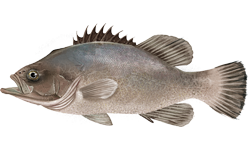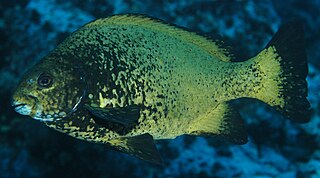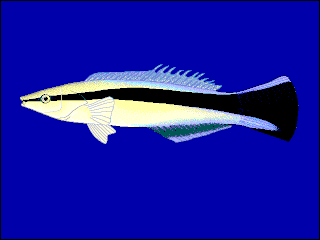
The wreckfish are a small group of ray-finned fish in the genus Polyprion, belonging to the monotypic family Polyprionidae in the order Acropomatiformes.

The sea chubs, also known as rudderfish and pilot fish and in Hawaiian as enenue or nenue, are a family, Kyphosidae, of fishes in the order Perciformes native to the Atlantic, Indian and Pacific Oceans usually close to shore in marine waters.

Stichaeidae, the pricklebacks or shannies, are a family of marine ray-finned fishes in the suborder Zoarcoidei of the order Scorpaeniformes. Most species are found in the North Pacific Ocean with a few in the North Atlantic Ocean.

Mendosoma lineatum, the telescope fish, real bastard trumpeter or common trumpeter, is a species of marine ray finned fish belonging to the family Latridae, the trumpeters. It is native to the subantarctic and cooler temperate waters of the Southern Ocean. It inhabits tide pools and surge channels and has been found living inside such invertebrates as salps. It occurs from near the surface to a depth of about 20 metres (66 ft). This species can reach a length of 40 centimetres (16 in) TL. This species was thought to be the only known member of its genus.

Pseudolabrus is a genus of wrasses native to the eastern Indian Ocean and the Pacific Ocean.

Oplegnathus is currently the sole recognized genus in the knifejaw family (Oplegnathidae) of marine centrarchiform ray-finned fishes. The largest, the Cape knifejaw, can reach a maximum length around 90 cm (35 in). Knifejaws have teeth fused into a parrot-like beak in adulthood. They feed on barnacles and mollusks, and are fished commercially. They are native to the Indian and Pacific Oceans.

Dermatolepis is a genus of marine ray-finned fish, groupers from the subfamily Epinephelinae, part of the family Serranidae, which also includes the anthias and sea basses. They are found in the western Atlantic, Pacific and Indian Oceans.

Plectropomus, commonly known as the coral groupers, is a genus of marine ray-finned fish, groupers from the subfamily Epinephelinae, part of the family Serranidae, which also includes the anthias and sea basses. They are found in the Indo-Pacific region.

Semicossyphus is a genus of wrasses native to the Pacific Ocean.

The Scorpidinae, commonly known as halfmoons, knifefishes, and sweeps, are a subfamily of the family Kyphosidae, the sea chubs, a family of marine fish in the order Perciformes. The Scorpidinae are distributed throughout the Pacific and east Indian Oceans, with species occurring in the waters of North America, South America, Asia, Australia, and numerous islands. Most inhabit the continental shelf in shallow rock and kelp reefs and deeper offshore reefs, whilst others are found well offshore in a pelagic setting. Most of the Scorpidinae are carnivorous, taking a variety of small crustaceans, although some are partly herbivorous. A number of the larger species are fished commercially and recreationally, and are considered good table fish.

Labroides is a genus of wrasses native to the Indian and Pacific Oceans. This genus is collectively known as cleaner wrasses, and its species are cleaner fish.

Bangana is a genus of fish in the family Cyprinidae, the carps and minnows. It is distributed across much of southern and eastern Asia. Species live mainly in the flowing waters of tropical and subtropical rivers.
Menziesichthys is a genus of marine ray-finned fishes belonging to the family Liparidae, the snail fishes. These are deep water fishes found in the Pacific Ocean.

Pseudocaranx is a genus of ray-finned fishes from the family Carangidae, the jacks, trevallies, scads, and pompanos. They occur in the western Atlantic Ocean and the Indo-Pacific.

Selene is a genus of carangids, commonly known as lookdowns and moonfishes, native to the Atlantic Ocean and the eastern Pacific Ocean.

Gomphosus is a small genus of wrasses native to the Indian and Pacific Oceans.
Malapterus reticulatus is a species of wrasse endemic to the Juan Fernández Islands in the southeastern Pacific Ocean. It is a cleaner of species in the genus Scorpis, eating the isopod ectoparasites in their mouths. This species is the only known member of its genus. It is found in shallow, coastal waters over rocky reefs.

Pentaceros is a genus of marine ray-finned fish, armorheads from the family Pentacerotidae. They are native to the Pacific, Indian, and eastern Atlantic Oceans. Pentaceros is the only genus in the monotypic subfamily Pentacerotinae.

The threadtail anthias is a species of marine ray-finned fish, an anthias from the subfamily Anthiinae part of the family Serranidae, the groupers and sea basses. It is the only member of the genus Tosana. It is found in the Western Pacific Ocean from Japan to the South China Sea in deep coastal waters over sandy-muddy substrates.

The school bass is a species of marine ray-finned fish, it is the only member of the monotypic genus Schultzea which is part of the subfamily Serraninae which itself is classified within the family Serranidae, along with the anthias and groupers. It is found in the western central Atlantic Ocean. This species is found in deeper waters near coral reefswhere it forms small groups which feed on plankton. The school bass is a synchronous hermaphrodite. The generic name honours the American ichthyologist Leonard Peter Schultz (1901-1986) who was Curator of Fishes at the United States National Museum who examined the specimens described by Loren P. Woods (1914-1979) as Schultzea campachanus, which was later shown to be a synonym of Hildebrand's Serranus beta.


















